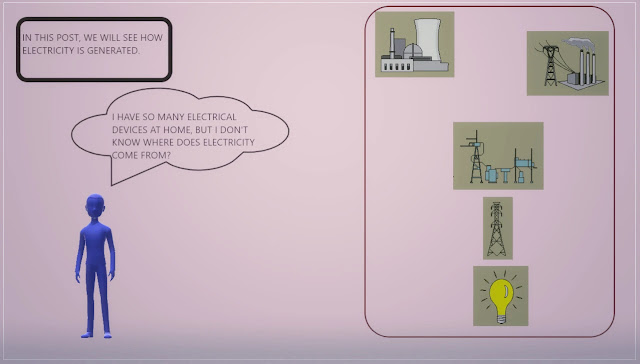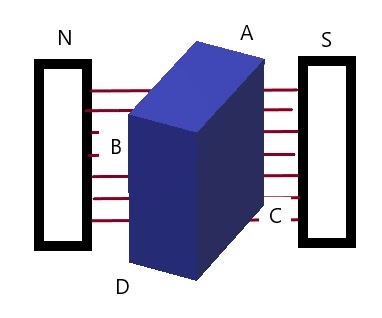How Is Electricity Generated
26 Oct, 2022.
In this post, we will see the basics of electricity generation.
Electricity is the most common and basic thing that we see around every day in our life. Without electricity, it is almost impossible to survive. It seems simple that we just switch on a plug and light turns on. But, in reality, there is a lot of process involved in bringing power supply to our reach. There are three stages of electric power supply – generation, transmission and distribution. In this post, we will see how electricity is generated.
·
What is electricity?
All the materials are made of atoms. Atoms have a positively charged nucleus and negatively charged electrons surrounding the nucleus. These electrons are bound to the nucleus due to their electromagnetic attraction to the oppositely charged nucleus. There are various shells build around a nucleus. Electrons in the outermost shell of the atom, called the valence shell, can sometimes become free due to external forces. These free electrons then move from one atom to another, causing movement of charge; and thus electricity starts to flow. This brings us to two types of materials – one conducting and one non-conducting. Conductors allow movement of these free electrons, and insulators (non-conductors) do not allow movement of free electrons. Refer the below image for more understanding.
In a neutral condition, the number of protons are equal to the electrons. But, if there is an imbalance in this count, then it means that a charge will flow now. When the number of protons are greater, then the atom becomes positively charged; and when the number of electrons are greater, then the atom becomes negatively charged. This is thus possible by losing or gaining electrons. Now, imagine a line containing these electrons. When this flow of electrons happen through a line, this means the line is charged and is now conducting electricity. Electrons move from a negative potential to a positive potential. In between both these potentials, a load is connected which proves as the resistance path for the current. Also, a switch must be connected to turn on or off the power supply. Refer the below image for understanding.
·
Alternator:
Now, let us move one step ahead to the working of an alternator. It is important to understand the operation of this equipment before we go further into electricity generation. Electricity is produced by electromagnetic induction according to Faraday’s law. In this, either the coil should rotate with respect to the magnetic field (rotating coil), or the magnetic field should rotate with respect to the coil (rotating magnetic field). In the case of an alternator, rotating magnetic field is used. Refer the below image for understanding.
The blue block shown is the rotor part (moving) and the black blocks shown with north and south poles are stator part (stationary). The rotor is excited by an external DC supply and has electromagnetic field around it. It is rotated by a different source. Due to this, the magnetic flux will also rotate along with it. Now, if you see, the rotor has four sides with A, B, C and D. The position of the coil initially is such that the coil is parallel to the flux, so no flux is cutting and therefore no current is induced. So, the waveform generated in that position is Zero degrees. Now, if the coil rotates in clockwise direction, then A and B will come in front of South Pole, and C and D will come in front of North Pole. So, now we can say that the motion of the conductor is perpendicular to the flux lines from N to S pole and the conductor cuts the magnetic flux. As the flux is cut, current is induced in the conductor (stator winding). This will first create a positive wave cycle.
Now, as the coil again rotates to 90 deg., the position of the coil initially is such that the coil is parallel to the flux; so no flux is cutting and therefore no current is induced. So, the waveform generated in that position is Zero degrees. Now, if the coil rotates again in clockwise direction, then C and D will come in front of South Pole, and A and B will come in front of North Pole. So, now we can say that the motion of the conductor is perpendicular to the flux lines from N to S pole and the conductor cuts the magnetic flux. As the flux is cut, current is induced in the conductor. This will create a first negative wave cycle. So, as emf is induced by cutting flux, electrical energy in AC current form is produced. The frequency produced is dependent on following formula – f=PN/120; where P is the number of poles on rotor and N is the rpm at which the rotor is rotating. For producing three phase current, two more stator coils which are 120 deg. apart are placed in the setup.
· How is electricity generated?
As we have learnt the basic concept of electricity and an alternator, it will now be easier to explain power generation. As we have seen in the alternator, the main part is rotating rotor. If we somehow manage to move the rotor at a fixed speed, then electrical energy will be induced in the stator windings. So, this is the basic concept of electricity generation – just move the rotor and you will get power; as shown in below figure.
Due to some external sources like steam, air or water, the series of blades mounted in a turbine are rotated. The shaft of the turbine is coupled to the rotor of an alternator and this force of rotation moves the rotor, and electricity is produced. This means that the mechanical energy is converted into electrical energy. In the case of steam, it is produced by natural gas, coal, nuclear fission, biomass, petroleum, geothermal and solar thermal. In the case of air, wind energy is used as in windmills. And, in the case of water, hydropower plants use the force of water to push the turbine blades. Apart from all these, one new technique that stands apart from this is solar cell photovoltaic generation. It does not require any moving part and is a complete different technology. Have a look at the below link to understand it more properly.
How Is Electricity Generated From Solar Energy
I have covered the general principle of electricity generation. I have also not attempted to cover every theory of these types deeply; you can learn it easily once you get familiar with them. I have just given you an insight of these types of generation. Once you are done with these, I am hopeful you will be easily able to understand any electrical generation system properly. Learn the basics and explore a new type of study in this type of engineering. It will take some practice and as you go on studying the generation, you will become more familiar with it.
Thank you guys; I hope you enjoyed reading the practices normally used for this type of study in industrial automation.








Comments
Post a Comment
If you have any queries, please let me know